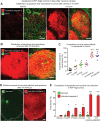Oncolytic Vaccinia Virus Gene Modification and Cytokine Expression Effects on Tumor Infection, Immune Response, and Killing
- PMID: 34045231
- PMCID: PMC8338778
- DOI: 10.1158/1535-7163.MCT-20-0863
Oncolytic Vaccinia Virus Gene Modification and Cytokine Expression Effects on Tumor Infection, Immune Response, and Killing
Abstract
Oncolytic vaccinia viruses have promising efficacy and safety profiles in cancer therapy. Although antitumor activity can be increased by manipulating viral genes, the relative efficacy of individual modifications has been difficult to assess without side-by-side comparisons. This study sought to compare the initial antitumor activity after intravenous administration of five vaccinia virus variants of the same Western Reserve backbone and thymidine kinase gene deletion in RIP-Tag2 transgenic mice with spontaneous pancreatic neuroendocrine tumors. Tumors had focal regions of infection at 5 days after all viruses. Natural killer (NK) cells were restricted to these sites of infection, but CD8+ T cells and tumor cell apoptosis were widespread and varied among the viruses. Antitumor activity of virus VV-A34, bearing amino acid substitution A34K151E to increase viral spreading, and virus VV-IL2v, expressing a mouse IL2 variant (mIL2v) with attenuated IL2 receptor alpha subunit binding, was similar to control virus VV-GFP. However, antitumor activity was significantly greater after virus VV-A34/IL2v, which expressed mIL2v together with A34K151E mutation and viral B18R gene deletion, and virus VV-GMCSF that expressed mouse GM-CSF. Both viruses greatly increased expression of CD8 antigens Cd8a/Cd8b1 and cytotoxicity genes granzyme A, granzyme B, Fas ligand, and perforin-1 in tumors. VV-A34/IL2v led to higher serum IL2 and greater tumor expression of death receptor ligand TRAIL, but VV-GMCSF led to higher serum GM-CSF, greater expression of leukocyte chemokines and adhesion molecules, and more neutrophil recruitment. Together, the results show that antitumor activity is similarly increased by viral expression of GM-CSF or IL2v combined with additional genetic modifications.
©2021 The Authors; Published by the American Association for Cancer Research.
Figures






Similar articles
-
Engineering of double recombinant vaccinia virus with enhanced oncolytic potential for solid tumor virotherapy.Oncotarget. 2016 Nov 8;7(45):74171-74188. doi: 10.18632/oncotarget.12367. Oncotarget. 2016. PMID: 27708236 Free PMC article.
-
Oncolytic and immunologic cancer therapy with GM-CSF-armed vaccinia virus of Tian Tan strain Guang9.Cancer Lett. 2016 Mar 28;372(2):251-7. doi: 10.1016/j.canlet.2016.01.025. Epub 2016 Jan 21. Cancer Lett. 2016. PMID: 26803055
-
GM-CSF and IL-21-armed oncolytic vaccinia virus significantly enhances anti-tumor activity and synergizes with anti-PD1 immunotherapy in pancreatic cancer.Front Immunol. 2025 Jan 3;15:1506632. doi: 10.3389/fimmu.2024.1506632. eCollection 2024. Front Immunol. 2025. PMID: 39830516 Free PMC article.
-
Recombinant Strains of Oncolytic Vaccinia Virus for Cancer Immunotherapy.Biochemistry (Mosc). 2023 Jun;88(6):823-841. doi: 10.1134/S000629792306010X. Biochemistry (Mosc). 2023. PMID: 37748878 Review.
-
The employment of vaccinia virus for colorectal cancer treatment: A review of preclinical and clinical studies.Hum Vaccin Immunother. 2022 Nov 30;18(6):2143698. doi: 10.1080/21645515.2022.2143698. Epub 2022 Nov 11. Hum Vaccin Immunother. 2022. PMID: 36369829 Free PMC article. Review.
Cited by
-
Oncolytic Viruses as a Novel Therapeutic Approach for Colorectal Cancer: Mechanisms, Current Advances, and Future Directions.Cancers (Basel). 2025 May 31;17(11):1854. doi: 10.3390/cancers17111854. Cancers (Basel). 2025. PMID: 40507337 Free PMC article. Review.
-
Research and Clinical Progress of Therapeutic Tumor Vaccines.Vaccines (Basel). 2025 Jun 23;13(7):672. doi: 10.3390/vaccines13070672. Vaccines (Basel). 2025. PMID: 40733649 Free PMC article. Review.
-
Oncolytic virotherapy augments self-maintaining natural killer cell line cytotoxicity against neuroblastoma.Cancer Immunol Immunother. 2024 Sep 5;73(11):221. doi: 10.1007/s00262-024-03818-y. Cancer Immunol Immunother. 2024. PMID: 39235531 Free PMC article.
-
Strategies for engineering oncolytic viruses to enhance cancer immunotherapy.Front Pharmacol. 2024 Sep 6;15:1450203. doi: 10.3389/fphar.2024.1450203. eCollection 2024. Front Pharmacol. 2024. PMID: 39309012 Free PMC article. Review.
-
A new strategy for treating colorectal cancer: Regulating the influence of intestinal flora and oncolytic virus on interferon.Mol Ther Oncolytics. 2023 Aug 24;30:254-274. doi: 10.1016/j.omto.2023.08.010. eCollection 2023 Sep 21. Mol Ther Oncolytics. 2023. PMID: 37701850 Free PMC article. Review.
References
-
- Breitbach CJ, Burke J, Jonker D, Stephenson J, Haas AR, Chow LQ, et al. . Intravenous delivery of a multi-mechanistic cancer-targeted oncolytic poxvirus in humans. Nature 2011;477:99–102. - PubMed
-
- Lawler SE, Speranza MC, Cho CF, Chiocca EA. Oncolytic viruses in cancer treatment: a review. JAMA Oncol 2017;3:841–49. - PubMed
Publication types
MeSH terms
Substances
Grants and funding
LinkOut - more resources
Full Text Sources
Other Literature Sources
Medical
Research Materials
Miscellaneous

